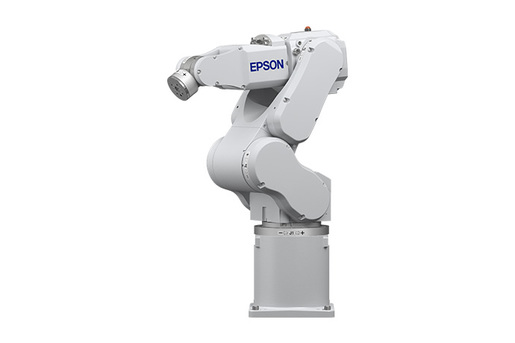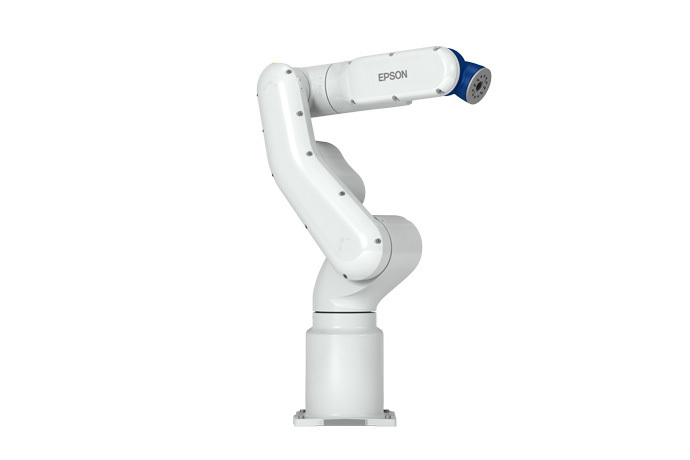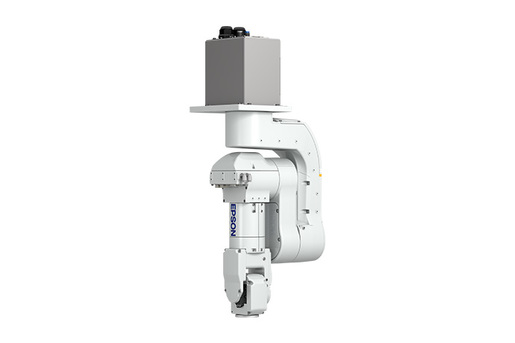
More and more manufacturers are using robotics systems to automate certain applications. If you’re looking to self-integrate a robotic system into your facility, you most likely have a lot of questions: What type of robot is right for my application? Which robot manufacturer is the best? How can I save money during the integration process? How do I make the robot controls interface to my existing equipment easy? In this article, we’ll specifically talk about 6-axis robots and their benefits and applications, why EPSON is the best robot manufacturer, and how to efficiently integrate robots into your workplace.
Characteristics & Capabilities of EPSON’s 6-Axis Robots
For almost four decades, EPSON has been one of the leading robot manufacturers in the world. Their 6-axis robots feature innovative, space-saving designs, and can be easily programmed with user-friendly software.
Their C, VT, and N 6-axis series are great for a wide range of applications, but there are some key differences to point out.
C Series

If you’re looking for an efficient use of floor space, the C series may be the right choice for you. The C Series is a line of 6-axis articulating arms. These robots have what’s called a “SlimLine design,” which makes it possible for them to access hard-to-reach areas that other traditional robots can’t access.
Additionally, the C series is designed to reduce incidents of singularity. These incidents can happen with 6-axis robots because they have more joints. When incidents of singularity occur, the robot arm will usually fault.
Lastly, there are three models in the C series: the C4/C4L, C8/C8L/C8XL, and C12. The C4 is both a tabletop- and ceiling-mounted model; it can handle payloads of up to 4 kilograms, and has a reach of up to 900 millimeters (around 35 inches). There is also an ISO 3 cleanroom version of this model.
The C8XL has a long reach up to 1,400 millimeters and can carry payloads up to 8 kilograms. These arms can be wall-, ceiling-, or table-mounted. Finally, the C12 is a table-mounted model; it combines a long reach of 1,400 millimeters with a powerful payload capacity of up to 12 kilograms.

VT Series
The VT series is one of the best options for manufacturers who are looking for the most value for their money. The only model in this series, the VT6L, is an all-in-one 6-axis articulating arm that is available at a surprisingly low price. Unlike other models, the VT6L robot has a built-in controller in its base, as well as external cable management for more options when using larger cable bundles. Lastly, this robot features 920 millimeters of arm length and a maximum payload of 6 kilograms, and can be used in ISO 4 cleanrooms.

N Series
Last but not least, with its one-of-a-kind 6-axis folding arm design, the N Series is the perfect robot for high-percentage reach access in limited space work areas. There are two models in this series: the N2 and N6. Both don’t require as much space as typical 6-axis robots.
The N2 features the world’s first folding-arm design, and is perfect for handling and assembling parts. It has an arm length of 450 millimeters and a maximum payload of 2.5 kilograms. The N6 is perfect for load and unload applications; it has a higher payloads up to 6 kilograms and a longer reach than the N2, extending to 1,010 millimeters.
Benefits
A 6-axis industrial robot is designed to move similarly to a human arm. As a result, it’s able to move in the x, y, and z planes, making it ideal for most industrial applications. These types of robots offer more degrees of freedom and angularity than SCARA robots.
Common Industry Applications of 6-Axis Robots
Versatile and reliable, 6-axis industrial robots are suited for applications in which complex movements are necessary. About 60 to 70% of industrial robots in manufacturing are 6-axis robots.
These types of robots are ideal for many high-speed applications that require precision, including:
- Painting
- Welding
- Assembly
- Material Handling
- Machine Loading
Why EPSON?

As previously mentioned, EPSON has been a leader in robot technology for nearly 40 years. They introduced the world’s first folding arm, and offer a wide range of smaller robots to suit almost any production need.
The biggest reason to choose EPSON is their incredibly intuitive software. Many robot manufacturers use teach pendants to teach points separately from the software to write the program. EPSON’s software is user-friendly and has an easy-to-use virtual teach pendant for jogging and teaching points which is fully integrated to their software. This small learning curve is especially helpful for workplaces that experience turnover, since there is minimal time teaching programming skills to new employees.
Should You Implement 6-Axis Robots?
While a 6-axis robot is extremely useful in many applications, it doesn’t mean it’s cost-effective for every situation. If your application only requires simple, flat-to-flat movement, a SCARA (4-axis) robot could be a more cost-effective choice. On the other hand, if your application requires more flexibility, or you need a robot that can carry a higher payload, you will most likely need a 6-axis model.
How to Integrate 6-Axis Robots Into Your Workplace
Self-integration can be a smart decision, but only when it’s done right. If you’ve made the decision to integrate 6-axis robots in your workplace, follow these steps for a more efficient process:
- Write down your goals and set realistic expectations. The most important question to ask yourself is: what are you expecting from this integration?
- Establish a good integration breakpoint, thus creating an automation sub-system with simple “handshakes.”
- Educate yourself and do the research. You need to know what type of industrial robot is suited for your needs.
- Assess your resources. Ask yourself if you have everything you need for the integration.
If it seems overwhelming, there is no need to do it alone. A robotics expert can help you make more efficient decisions.
Have Questions? Contact Schneider & Co. Today
Do you still have questions about 6-axis robots and self-integration? Turn to our robotics experts at Schneider & Company. Founded in 1928, we’re an EPSON distributor. In addition to helping manufacturers, we also provide robotics programming courses and robot vision guidance courses for both new and advanced learners.
For general questions, or to request a product quote or demo please fill out our online form today, and one of our team members will be in touch with you shortly.
